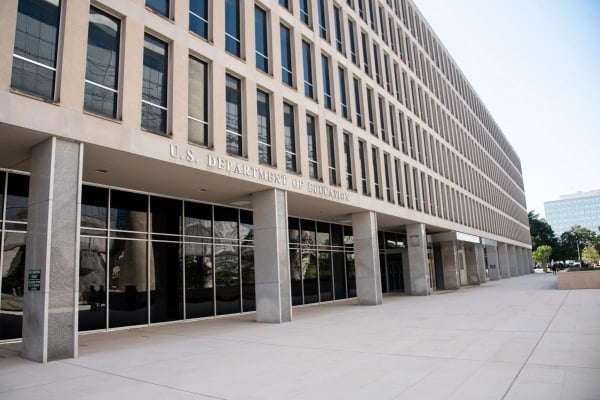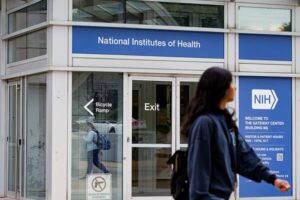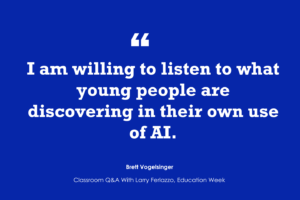
Education Dept. Hears From Public About Higher Ed Overhaul
The Education Department’s yearlong effort to roll out the sweeping higher ed changes signed into law last month kicked off Thursday with a four-hour hearing that highlighted the many tweaks college administrators and others want to see.
The law, known as the One Big Beautiful Bill Act, capped federal student loans, created new loan-repayment plans, extended the Pell Grant to include short-term workforce programs and instituted a new measure to hold institutions accountable. Now, the department is planning to propose and issue new regulations that spell out how those various changes will work.
On nearly all fronts, college administrators, policy experts and students argued that lawmakers left significant gaps in the legislation, and they want a say in how Trump administration officials fill them in. For instance, the legislation doesn’t explain what data will be collected for either workforce Pell or the accountability measure or who will have to take on that task. Some speakers raised concerns about how new reporting requirements could increase administrative burdens for colleges.
But Nicholas Kent, the department’s newly confirmed under secretary, said at the start of the meeting that he looks forward to clarifying all the details during the lengthy process known as negotiated rule making.
“Simply put, the current approach to paying for college is unsustainable for both borrowers and for taxpayers,” Kent said. “President Trump has laid out a bold vision, one that aims to disrupt a broken system and return accountability, affordability and quality to postsecondary education that includes reducing the cost of higher education, aligning program offerings with employer needs [and] embracing innovative education models … Today’s public hearing marks a key milestone in our accelerated timeline to implement this sweeping legislative reform.”
Neither Kent nor other department officials said what specific changes and clarifications are on the table.
What Is Negotiated Rule Making?
Negotiated rule making, or “neg-reg,” started in the early 1990s. It entails using an advisory committee to consider and discuss issues with the goal of reaching consensus in developing a proposed rule. Consensus means unanimous agreement among the committee members, unless the group agrees on a different definition. The department must undertake negotiated rule making for any rule related to federal student aid.
Determining the details of the regulations and policy changes will be left up to two committees of higher education leaders, policy experts and industry representatives that will review and negotiate over the department’s proposals during a series of meetings throughout the fall and into the new year. The first committee is scheduled to begin discussions in September.
In the meantime, here are three key issues Thursday’s speakers said they hope to see addressed by both the advising panels and department officials before the legislation starts taking effect in July 2026.
Who’s Making the Decisions?
Before the public hearing, some higher ed lobbyists and advocates raised concerns about who would be included on the advisory committees. Multiple constituent groups argued they weren’t properly represented on the committees.
For instance, neither committee includes a representative from the financial aid community, despite the fact that college financial aid administrators will play a key role in implementing the legislation on campuses.
Multiple groups, including the American Council on Education, drew attention to the absence, but Melanie Storey, president of the National Association of Student Financial Aid Administrators, voiced the most concern.
Financial aid professionals will “interpret, communicate and operationalize the intricate details of this wide-ranging bill for millions of students and families. To exclude their practical, technical experience from the negotiation table risks developing rules that are difficult to administer, creating unintended negative consequences,” she said. “We have heard the perspective that representatives from each college sector can speak to the needs of their institutions. However, their role is to advocate for the broad interests of that sector. That is fundamentally different from representing the profession responsible for the … mechanics of aid delivery.
A department official who moderated the hearing, responded, “We expect we will have financial aid administrators at the table,” as the department has in the past, but he did not clarify how that would be done. (This paragraph has been corrected.)
Other speakers called for better representation of civil rights advocates, apprenticeship program leaders and minority-serving institutions, but none of those requests were directly addressed by government officials.
What Qualifies as a Professional Program?
Speakers also raised questions about how the new caps to student loans would work and whom they would affect.
How to Make a Policy, Neg-Reg Edition
As part of negotiated rule making, the Education Department must:
Put out a public notice about intent to form a committee and hold a public hearingPublish notice inviting nominations for negotiatorsHold a public hearing- Pick the negotiators
- Hold negotiated rule-making sessions
- Write the proposed regulations
- Publish those regulations for public comment, which lasts at least 30 days
- Read and respond to the comments; revise the regulations as needed
- Publish the final rule. Rules need to be published by Nov. 1 in order to take effect July 1 of the following year, but the department can implement rules early.
Congress’s Big Beautiful Bill caps loans for professional degrees at $200,000 and limits loans for graduate programs to half of that. But lawmakers didn’t specify which degree programs fall in which category. Determining how to sort programs will likely be a key point of debate for the rule-making committee, the comments showed.
Certain programs, like law and medical school, will almost certainly be considered professional programs, but other programs, like master’s degrees in nursing, education or social work, are not guaranteed. Knowing this, a variety of academic association representatives, workforce advocates and college administrators made their case throughout the hearing for why their own discipline should be a professional program.
Matt Hooper, vice president of communications for the Council on Social Work Education, said to not include certain programs in the professional bucket would mean ignoring their critical nature as a public service.
Social work graduates “pursue careers in health care, children and family services, criminal justice, public policy, government, and more,” he said. “An M.S.W. provides full professional preparation, similar to a J.D. in law or an M.D. in medicine, and we think it should be categorized in the same respect.”
A handful of speakers went so far as to argue that certain bachelor’s programs, like aviation or aeronautical science, that are often paired with certification from the Federal Aviation Administration should be grouped into the professional category, as they come at a cost and time commitment similar to graduate school.
If those programs don’t get the benefit of a higher loan cap, multiple airline advocates said, America could see a steep shortage of pilots within the next two decades.
“Over the next 15 years, nearly half of our nation’s airline pilots will retire due to mandatory age limits,” said Sharon DeVivo, president of Vaughn College of Aeronautics and Technology. “The current training pipeline is not equipped to meet that demand, putting at risk the transportation infrastructure, especially the economic health of small and rural communities that depend on reliable air service.”
Training to become a pilot can cost $80,000 to $100,000 more than a traditional bachelor’s degree, added Carlos Zendejas, vice president of flight operations at the regional airline Horizon Air. So to hold these students to the same loan limit as other undergraduates would deter prospective pilots from pursuing a high-return-on-investment career.
“The need to stabilize the pilot pipeline is real,” he said. “The One Big Beautiful Bill gives the department the ability to fix this.”
Should Gainful Go?
Since the inauguration, Trump officials in all sectors of the federal government have been vocal about combating fraud, waste and abuse. But higher education experts are concerned that one measure in the reconciliation bill could do the opposite.
The new accountability tool it introduced uses a new earnings test to evaluate colleges’ eligibility for federal student loans. But it does not apply to certificate programs, which some policy and data analysts say are more likely to provide a poor return on investment.
According to a recent report from the Postsecondary Education and Economics Research Center at American University, only 1 percent of college programs at the associate level and higher will fail the new earnings test, but about 19 percent of certificate programs would do so.
Representatives from American as well as New America, Third Way and the Century Foundation, all progressive think tanks, sounded the alarm on the matter at Thursday’s hearing. As a solution, they encouraged the administration to keep an existing accountability policy in place that applies to certificate programs and for-profit institutions. That metric, known as the gainful-employment rule, is not codified in law.
“A recent publication from the Senate health committee’s chairman, Bill Cassidy, confirms it was not lawmakers’ intent to exempt such programs from any accountability,” said Clare McCann, the PEER Center’s managing director of policy and operations. “So to carry out that intent, the department should maintain a strong gainful-employment program regulation for those programs that should include maintaining the debt-to-earnings tests under the gainful-employment rules, which are an important check on institutions offering unaffordable degrees.”
Source link



